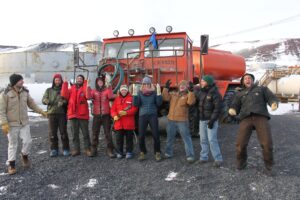A few weeks ago, a reader asked when it made sense to buy economically for polar travel and when to splurge. He mentioned how his cheap pair of gloves outperformed and outlasted an expensive pair. On the other hand, he never regretted paying $40 for a great pair of cold-weather socks.
It’s a good question, and one I can relate to. Before my first expedition, I had no one to advise me, and online resources weren’t available. So I erred on the side of caution and bought the best of everything. It wasn’t necessary, but it ensured that I would not skimp on the wrong item. I had enough natural expedition smarts to ask companies for a pro deal, even though I wasn’t a pro. Many companies agreed, and I saved a lot of money that way.

Generic travel clothing is fine, but don’t skimp on camp gear. Photo: Jerry Kobalenko
Travel vs camp gear
In time, I learned when it’s necessary to buy A-list equipment and when it isn’t. There is one general principle: Save money on travel gear, spend it on camp gear.
So the high-ticket items include a tent, sleeping bag, and polar parka for wearing around camp. I’d also put boots in this category.
On the other hand, travel gear does not need the same standards, because no matter how cold it is, what you wear manhauling is the same that you’d wear backcountry skiing or winter hiking. The usual layers: underwear, fleece if it’s cold, a wind shell. Exercise warmth turns 40˚ below into what feels like just -10˚C. You still need protection, but you’re generating so much warmth yourself that you can get by with basic choices.
So while a $900 Norrona or Arcteryx shell is lovely, any old jacket with a few pockets in which to stuff candy bars and odds and ends will suffice.
Once you reach camp and stop being a furnace, get the warmest clothing you can buy. You will need it.
This said, there are arguments for purchasing upscale with other gear too, especially if you want to do more than one expedition or two. Unlike summer clothing, winter layers amortize very well. Snow and cold create a gentle environment: No dirt, no abrasion, no mud, no sharp twigs or little stones, not even any rain to strip the DWR coating off a shell. I am still wearing stuff I wore 15 years ago, including socks, undergarments, and fleece mid-layers. My ski bibs are older than that. I change my shell occasionally, not because it needs replacing but because the photos begin to look too similar, one expedition to the other. Sometimes, certain colors go just too far out of fashion to endure, like those neon Lycra tights that old Yosemite climbers wore. Otherwise, a lot of winter clothing is essentially immortal, assuming that you don’t, er, grow out of it.
Finally, if you’re on a shoestring budget, you can even make a case for spending less on camp gear. You will suffer more than you have to, but if you enjoy expedition life, even that is not a game-ender.

Polar clothing like ski bibs can last a lifetime. Photo: Jerry Kobalenko






